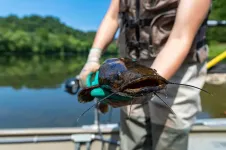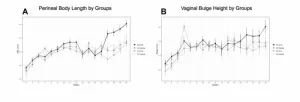(Press-News.org) UNIVERSITY PARK, Pa. — Flathead catfish — native to the Mississippi River basin — were first detected in the Susquehanna River in Pennsylvania in 2002, according to the U.S. Geological Survey. In the two decades since then, the invasive species has spread throughout the river basin. The impact of the large predator on the waterway’s food webs and ecology was unknown, but now a research team is beginning to understand what Susquehanna flatheads are eating and how their presence is affecting native aquatic species in the river.
The findings, which the team said state fisheries managers can use to better manage the waterway, were recently published in Transactions of the American Fisheries Society. The researchers from Penn State, the Pennsylvania Fish and Boat Commission, the U.S. Fish and Wildlife Service, and the U.S. Geological Survey, reported that flatheads are opportunistic feeders preying on dozens of aquatic species. The invaders are voracious and have become the apex predators in the river — some specimens are known to grow more than 4 feet long and nearly 70 pounds in Pennsylvania waters. They have great potential to affect the abundance of riverine fish species, according to the researchers.
“We conducted the first flathead catfish population diet study in a mid-Atlantic region waterway because it was unknown how this invader is impacting food webs and which species may be at greatest predation risk,” said study coauthor, Megan Schall, associate professor of biology at Penn State Hazleton. “Flathead catfish in waters where they are not native pose a threat to aquatic communities.”
To determine what the flathead catfish were eating, researchers collected 576 of them over two years using electrofishing and hoop net capture methods, as well as collection from the Conowingo Dam fish lift, with 241 individuals having recoverable stomach contents. The researchers extracted DNA from those contents and identified prey tissues using a molecular genetics technique known as DNA bar coding. Researchers conducted genetic sequencing of selected stomach contents at the Genomics Core Facility at Penn State’s Huck Institutes of the Life Sciences.
In all, researchers identified 47 different prey species. Thirty-four of the species detected were at a low frequency, occurring in less than 2% of fish sampled. The most common were rusty crayfish, margined madtoms — a variety of catfish typically 2 to 3 inches long, considered to be a species of conservation concern — and shiners, which are silvery minnows. While frequency of occurrence of prey species differed depending on the length of flathead catfish, rusty crayfish were found in the stomachs of almost half the fish sampled in the study.
Among other prey species identified were blueback herring, gizzard shad, northern hog sucker, shorthead redhorse, goldfish, river chub, bluntnose minnow, longnose dace, white catfish, brown bullhead, channel catfish, flathead catfish, banded killifish, rock bass, green sunfish, bluegill, smallmouth bass, white crappie, black crappie, white perch, greenside darter, yellow shield darter and walleye.
Not surprisingly, the researchers said, with increasing flathead catfish size comes a proclivity to feed on larger prey. In general, flatheads over 24 inches long primarily consumed fish species, and fish below 24 inches generally fed on a mix of invertebrates and fish species.
Learning that flathead catfish in the Susquehanna River basin are consuming a diverse set of prey species, including species of recreational importance — smallmouth bass, rock bass, channel catfish and walleye — and species of conservation importance — blueback herring and margined madtom — will help fisheries managers who oversee the river, according to Schall.
“Identifying prey species consumed by this invasive predator is one of the first steps in elucidating potential community-level impacts from this actively expanding aquatic invasive species,” she said. “That knowledge is vital for determining potential management solutions to a novel invader.”
The discovery that flathead catfish in the Susquehanna River are consuming so many rusty crayfish — themselves an invasive species that are largely supplanting native crayfish species in the U.S. Northeast — was especially interesting, said research team leader Julian Avery, assistant research professor of wildlife ecology and conservation in the College of Agricultural Sciences.
“These invasive species likely ended up in the Susquehanna River because of human tampering — anglers moving them around — and the scale of what can go wrong with ecosystems as a result is eye-opening,” he said. “We are only now coming to grips with the effect these aquatic invaders are having on river ecosystems.”
Also contributing to the research were Geoffrey Smith, Pennsylvania Fish and Boat Commission, Division of Fisheries Management; Aaron Maloy and Jason Coombs, U.S. Fish and Wildlife Service, Northeast Fishery Center, Lamar, Pennsylvania; and Tyler Wagner, U.S. Geological Survey, Pennsylvania Cooperative Fish and Wildlife Research Unit at Penn State.
The Pennsylvania Sea Grant, Penn State Commonwealth Research and Development Program and Mid-Atlantic Panel on Aquatic Invasive Species provided funding for this research.
END
Invasive flathead catfish impacting Susquehanna’s food chain, researchers find
Study’s findings may help inform Pennsylvania river management as the large, hungry predators continue spreading throughout the basin
2024-10-22
ELSE PRESS RELEASES FROM THIS DATE:
Javadi receives DOE Early Career Award to study qubit hosts
2024-10-22
NORMAN, OKLA. – Alisa Javadi, Ph.D., professor at the University of Oklahoma School of Electrical and Computer Engineering and the Homer L. Dodge Department of Physics and Astronomy, has received funding from the U.S. Department of Energy Early Career Research Program for research that offers the potential for advancing quantum technology development.
Javadi’s research will test the use of cerium oxide as a host for quantum bits, or qubits. Qubits, the building blocks of quantum computing, need an environment free ...
Obesity Medicine Fellowship created at Pennington Biomedical
2024-10-22
Obesity Medicine Fellowship Created at Pennington Biomedical
Fellowship product of collaboration between Pennington Biomedical Research Center’s Metamor Clinic and Louisiana State University Health New Orleans School of Medicine
FOR IMMEDIATE RELEASE
Oct. 22, 2024
BATON ROUGE – A new Obesity Medicine Fellowship at Pennington Biomedical Research Center is now open for candidate applications. The one-year program is the result of a collaboration between Pennington Biomedical and Louisiana State University Health ...
Structural biology analysis of a Pseudomonas bacterial virus reveals a genome ejection motor
2024-10-22
BIRMINGHAM, Ala. – The viruses that infect bacteria are the most abundant biological entities on the planet. For example, a recent simple study of 92 showerheads and 36 toothbrushes from American bathrooms found more than 600 types of bacterial viruses, commonly called bacteriophages or phages. A teaspoon of coastal seawater has about 50 million phages.
While largely unnoticed, phages do not harm humans. On the contrary, these viruses are gaining increasing popularity as biomedicines to eradicate pathogenic ...
Remote tool developed to helped detect autism and developmental delay in children with limited access to specialists
2024-10-22
A Ukrainian researcher has developed a new digital tool for detecting autism and developmental delay in children. Her research has been published in Cambridge University Press journal Cambridge Prisms: Global Mental Health.
The tool incorporates the basic principles of the Kids’ Development Diagnosis and Determining the Risk of Autism (KiDD) methodology, for children aged 1.5 to 6 years old, into mobile app form. It has the potential to help diagnose children more swiftly and efficiently, which could have major positive ...
Texas Accounting Chair Steven Kachelmeier garners coveted award for scholarship
2024-10-22
Texas Accounting Chair Steven Kachelmeier Garners Coveted Award for Scholarship
AUSTIN, Texas — The American Accounting Association (AAA) presented its Lifetime Achievement Award for Behavioral Accounting Research to Steven Kachelmeier, a professor and chair of the Department of Accounting at The University of Texas McCombs School of Business. Kachelmeier, the Thomas O. Hicks Endowed Chair in Business, accepted this prestigious award during the weekend at the association’s 2024 Accounting ...
CABHI launches funding program that ignites innovation to advance healthy aging
2024-10-22
TORONTO, Oct. 22, 2024 – Today, the Centre for Aging + Brain Health Innovation (CABHI), powered by Baycrest launched Ignite, its new funding program to support Canadian innovators designing solutions for older persons. As Canada’s aging population rapidly grows – with nearly 20 per cent of people above the age of 65 – so too will the need for innovations that enhance the lives of older persons, including those impacted by dementia.
Canadian early-stage innovators – including researchers, point-of-care staff, and companies – are developing ...
A fully automated AI-based system for assessing IVF embryo quality
2024-10-22
A new artificial intelligence-based system can accurately assess the chromosomal status of in vitro-fertilized (IVF) embryos using only time-lapse video images of the embryos and maternal age, according to a study from investigators at Weill Cornell Medicine.
The new system, called "BELA,” and described in a paper published Sept. 5 in Nature Communications, is the team’s latest AI-based platform for assessing whether an embryo has a normal (euploid) or abnormal (aneuploid) number of chromosomes—a key determinant of IVF success. Unlike prior AI-based approaches, BELA does not need to consider embryologists' subjective assessments of embryos. ...
Senolytics dasatinib and quercetin for prevention of pelvic organ prolapse in mice
2024-10-22
“This study represents one of the first to evaluate the impact of senolytic agents D+Q on the clinical development of pelvic organ prolapse and expression of proteins associated with cellular senescence in a mouse model.”
BUFFALO, NY- October 22, 2024 – A new research paper was published in Aging (listed by MEDLINE/PubMed as "Aging (Albany NY)" and "Aging-US" by Web of Science), Volume 16, Issue 19 on September 26, 2024, entitled, “Use of the senolytics dasatinib and quercetin for prevention of pelvic organ prolapse in a mouse animal model.”
Pelvic organ prolapse is a common condition among women ...
UCLA efforts to provide prostate cancer treatment in the community gets $6 million boost
2024-10-22
The UCLA Urology department has been awarded $6 million from the California Department of Health Care Services to continue providing vital care and critical services to underinsured and uninsured Californians diagnosed with prostate cancer.
For the next two years, the additional funding will support the 23-year-old IMPACT program—which stands for Improving Access, Counseling, and Treatment for Californians with Prostate Cancer—and extend the program’s reach and duration, ensuring continued support for California’s most vulnerable populations.
Led ...
Study asks: Can cell phone signals help land a plane?
2024-10-22
ALBUQUERQUE, N.M. — Dangling from a weather balloon 80,000 feet above New Mexico, a pair of antennas sticks out from a Styrofoam cooler. From that height, the blackness of space presses against Earth’s blue skies. But the antennas are not captivated by the breathtaking view. Instead, they listen for signals that could make air travel safer.
Researchers from Sandia National Laboratories and Ohio State University are taking experimental navigation technology to the skies, pioneering a backup system to keep an airplane on course when it cannot rely on global positioning system satellites.
More than 15 miles below the floating cooler, cell phone ...
LAST 30 PRESS RELEASES:
The perfect plastic? Plant-based, fully saltwater degradable, zero microplastics
Bias in data may be blocking AI’s potential to combat antibiotic resistance
Article-level metrics would provide more recognition to most researchers than journal-level metrics
Satiety’s little helper: Protein that supports appetite regulating protein identified
UF dives deep into predicting storm damage with computer models
A stormy ocean voyage yields insights on the global carbon cycle
Scientists identify first non-coding gene that controls cell size
Demonstration of altermagnetism in RuO₂ thin films -- A new magnetic material for the AI era
Penn researchers awarded $25M to conduct trial using smartphones to fight heart disease
PCORI awards funding for new patient-centered healthcare research
Exploring the origins of the universe: 145 low-noise amplifiers complete ALMA telescopes
Empress cicada wings help illuminate molecular structure
Using sound waves to detect helium
Time burden in patients with metastatic breast and ovarian cancer from clinic and home demands
Researchers discover bias in AI models that analyze pathology samples
Scientists ID potential way to prevent brain injuries from triggering Alzheimer's
MASTER 2nd Open Call: Execution period kick-off
Algae for health in food and pharma
Advanced microrobots driven by acoustic and magnetic fields for biomedical applications
Chicago health information leader recognized for raising CPR readiness and blood pressure awareness
The Intimate Animal, a new book from Kinsey Institute Executive Director Dr. Justin Garcia
When blue-collar workers lose union protection, they try self-employment
New video dataset to advance AI for health care
MEA-based graph deviation network for early autism syndrome signatures in human forebrain organoids
New modeling approach sheds light on rare gut disease
Study documents potentially hazardous flame retardants in firefighter gear
Can certain bacteria regulate aging of the immune system and its related alterations?
AI model helps diagnose often undetected heart disease from simple EKG
There are fewer online trolls than people think
Cell membrane fluctuations produce electricity
[Press-News.org] Invasive flathead catfish impacting Susquehanna’s food chain, researchers findStudy’s findings may help inform Pennsylvania river management as the large, hungry predators continue spreading throughout the basin






